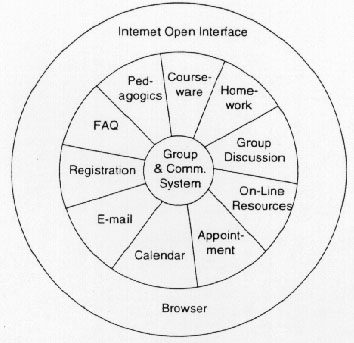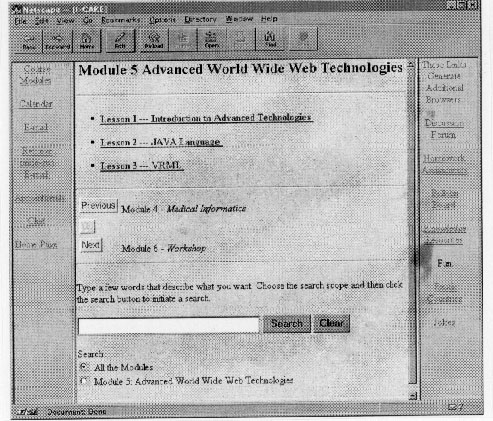CYBERSPACE ASSISTED RESPONSIVE
EDUCATION
IMPLEMENTED ON THE OPEN PLATFORM - INTERNET
ABSTRACT
Cyberspace Assisted Responsive Education (CARE) is a concept of exploiting advanced information and communication technologies to provide learners and teachers with a friendly education/training system and environment. CARE advocates a M to N group teaching and learning methodology, a hyper-learning courseware and a non-linear learning process. CARE was first implemented on the Internet which provides an open platform for application system developers to construct and integrate easily a complex system. The Internet interactive teaching and learning system that was developed is called I-CARE which is principally built on a cross-platform web server using cross-platform languages such as Perl and Java. The functions of I-CARE are described which include a set of communication tools, learning tools, research tools and authoring tools as well as a courseware, Internet Informatics, designed for engineers. The operation of I-Care is illustrated. The courseware is modularly constructed as an example to demonstrate how group interactive hyper-teaching/learning is practiced on the Internet. Teaching/learning experience with the I-CARE platform and the Internet informatics course are summarized. The future outlook of I-CARE is discussed.
The complete solution of I-CARE can be accessed on http://pride-sun.poly.edu/icare.
INTRODUCTION
Cyberspace Assisted Responsive Education ( l ) is an education and training system inspired by the observations of paradigm shifts in education. It recognizes that younger generation learners well exposed to television, electronic games, CD-ROMs, personal computers and Internet access have acquired a different learning style, a non-linear (non-sequential) learning style. It further recognizes that most industry jobs require their new hires and their current employees, especially engineers, to keep up with technology advances and to maintain skill competency on the job. Any training provided if at all is usually on an on-demand basis. Hence a learner friendly and flexible education and training system that can provide just-in-time learning or education-on-demand is very much desired. However, the traditional education methodology has remained in the classroom with little innovative transformation. The recent distance learning (2,3) movement, although exploiting the telecommunication and computer technologies, it is overly focused on the distance issue and resource sharing problem. Most efforts did not address the pedagogy or the teaching and learning methodology issue. (4) Therefore, the effectiveness of distance learning has been questioned. CARE is a concept exploiting the advanced communication and computer technologies for the purpose of developing a learner and teacher friendly environment. It is designed to provide new tools for teachers to explore pedagogical innovations. It does make two fundamental assumptions that a non-sequential hyper-learning style and an highly interactive group teaching and learning methodology will provide more effective learning. These techniques were practiced in the traditional classrooms before, however, they were limited by resources available or affordable. Of course, they were also hampered by the space and distance limitations which make instructor and classroom scheduling difficult.
Although the CARE concept can be implemented in a variety of telecommunication and computer infrastructure, it can be most efficiently implemented on the Internet with ordinary PC technology. Internet provides an Inverted Open Platform (IOP) (5, 6), i.e., its webspace user interface (known as browser) is truly open and cross platform. So the open platform of Internet is looking from the user interface down rather than looking from a particular operating system up, hence the term IOP. This inverted open platform allows application developers to pick and choose application system components independent of the operating system to construct or to integrate a complex application system such as the interactive learning system (1).
Based on the concept of IOP, we have implemented a highly interactive hyper-learning system on the Internet for group teaching and learning. We named our system I-CARE. ICARE is a virtual classroom with a very rich set of communication, learning and research tools to eliminate the space or distance limitation and resources restrictions in the conventional classroom. In addition, Internet learning gives the teachers and learners the most flexible schedule both from time and place point of view. Therefore, I-CARE is a distanceless, cyberspace assisted, group interactive and hyper learning solution platform open to and accessible by the public via Internet.
DESIGN AND FUNCTIONS OF I-CARE
I-CARE is a computer mediated education system for bringing students and teachers together in a virtual learning environment over the Internet. The system provides the following functions for three classes of users:
The entire system is integrated on the Internet, based on the "inverted open platform" concept. A demo course is available for users to experience the above described functions with limited course content.
The architecture of I-CARE system is derived from the Internet open platform concept described above. Fig.1 depicts a generic architecture for I-CARE as a client-server architecture. Above the dash line, it shows a web server and browser client system where the I-CARE server and client components are represented as modular components (A1, A2, ...An, JS, JA and APPs). These components are integrated and interfaced with the Internet open interface with CGI scripts, JAVA script and/or JAVA programs. The diagram below the dash line simply depicts that the system uses the common communication protocol, http and tcp/ip over the Internet. The I-CARE system components can run on different operating systems (same as web server and browser) hence making the integration of the system flexible with respect to the choice of an operating system.

Fig. 2
Functionally, the above system requirements or components may be represented by a diagram showing in Fig. 2 to indicate how they are integrated together with a common Internet user interface and how they may be used together to provide a total solution for delivering a group interactive hyper learning courseware in the Internet virtual classroom. As shown, the outer ring is the common user interface, the web browser, which can access all the functional components for administration, courseware, communication, learning tools and on-line links. The inner circle represents the back-end support for the application components running on one or different operating system platforms.
DESCRIPTION OF I-CARE OPERATION
The functional diagram of I-CARE as represented in Fig. 2 is accessible and visible to the users from the Internet browser. We have used the Netscape browser and Netscape web server (both of which are cross platform) in our system, although Microsoft's Internet Explorer can be used just as well.
Since I-CARE is now operational on the Internet, hence one can simply access the system (http://pride-sun.poly.edu/icare) to get familiar with the operation of I-CARE. The operation is fairly intuitive. From the I-CARE homepage, one may click the I-CARE demo to navigate through the system. One simply clicks on a given application component to experience its function. For example, one can click on pedagogics to get a background description of I-CARE philosophy. One can click registration to do on-line registration. After registration, one can enter (log-in) the course with a password. (In the demo course, userid and password are provided with no need to register) Our current system user interface uses two side frames (columns) to list and interface with the application components and uses the center frame as the principal window for the application. After entering into the course or virtual classroom, one can see that the two side frames list all system components which support the teaching and learning. If one clicks a function, the application is brought into the center frame, for example, one may bring in the course module or the calendar or appointment book, etc.
For some functions, we decided to create a separate browser in parallel with the first browser interface because the user may need to refer to the first browser while working with the second function. An example of this is that while the user is browsing the courseware, he encounters a homework assignment or feels like to create a discussion group on the topic he is learning, he can select the homework function or the group discussion function which will create a second browser window. He can then proceed to do the homework while keeping his course material in display in the first window. Depending on the screen size the user has, one may have to move and/or resize the two browser windows to achieve the multitasking capability.
There are numerous details in the functions provided. For example, the appointment tool provides choices of communication with telephone or computer chat in real time. Another example, the homework assignments are preloaded into the homework assignment tool. We tried to make these functions very intuitive, however, later experience (see discussion below) tells us that a help menu, perhaps even a human help desk, may still be desired.
COURSE OFFERING AND EXPERIENCE WITH I-CARE
We have designed a course entitled Internet Informatics offered on I-CARE. This course was offered during the summer of 1996 as a non-credit one month course delivered with I-CARE without any physical classroom meetings. The course material was designed with hypertext containing very rich URL links to many relevant information sources. We have built in a navigation tool in the course module to facilitate ease of navigation and learning. In addition, we have included a search engine in the course module to facilitate dynamic search on specific topics within the course material which not only has a broad coverage of teaching/learning content but also has many pointers to further studies.
Although the course was offered in a commercial manner (i.e. fees are charged) but one of our main purposes is to evaluate I-CARE. We did receive an enrollment of 30 students mostly industrial professionals from large corporations. The corporate students paid the $600 course fee hence they were serious about the course. The experiences we gained as instructors plus some student feed-backs we received gave us the following conclusions:
CONCLUSIONS
The rapid advancement of the WWW and Internet technology and information processing tools have made on-line interactive teaching and learning a viable supplement to traditional classroom teaching and learning. There is still a certain amount of uncertainty about the correct methodology and effectiveness of on-line interactive teaching and learning. There is also the neglect of treating the entire teaching process, (the three phases of preparation, delivery and assessment, and their associated administrative procedures) in a total solution design. I-CARE is an attempt to provide such a total solution. It may be used in-class or on-line. It is offered as a system for educational institutions to experiment with or with which to develop full curricula to bring out their best intellectual content for I on
The I-CARE system is available on the Internet for inspection. A user manual is available to be used as a guide for downloading the software, administering the system and/or performing teaching and learning roles. Fig. 3 gives the I-CARE virtual classroom.

Fig. 3
REFERENCES
1. Ifay F. Chang, Paradigm Shifts in Education and A Future Education Solution, Global Information and Software Society Internet Conference, GISSIC95, http://pride-i2.poly.edu/GISS, 19 print pages
2. Nizar Al-Holou and Timothy W. Savage, Development of an Advanced Delivery Classroom at the University of Detroit Mercy, IEEE Frontiers in Education Conference, Session 5D4, 562-566, 1994
3. P. Rossman, The Emerging World Wide Electronic University, Greenwood Press, Westport, CT, 1992
4. Donald I. Barker, A Technological Revolution in Higher Education, J. Educational Technology Systems, Vol. 23(2), 155-168, 1994-95
5. Ifay F. Chang, Network-Centric, Group-Centric and Human-Centric Information Processing Systems, 11th International Conference on Information Networking, I-COIN, Taipei, 1997; Group-Centric Information Processing Systems, http:pridei2.poly.edu/GISS Global Information Software Society International Conference proceedings, GISSIC96, 1996
6. Ifay F. Chang, Open Platform Group-Centric and Network-Centric Information Processing System, proceedings of The 2nd World Conference on Integrated Design and Process Technology, IDPT96, Vol.2, pp 31-36, 1996